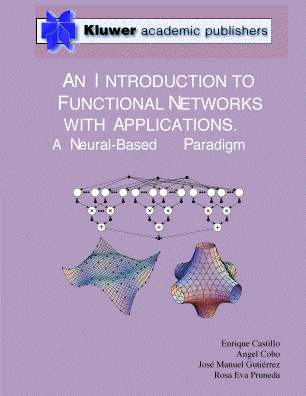| PREFACE |
|
ix | |
| I NEURAL NETWORKS |
|
1 | |
|
1 Introduction to Neural Networks |
|
|
5 | |
|
|
|
5 | |
|
1.2 Inspiration from Neuroscience |
|
|
6 | |
|
1.3 Components of Neural Networks |
|
|
7 | |
|
|
|
13 | |
|
|
|
14 | |
|
1.6 The Hopfield Neural Network |
|
|
16 | |
|
1.7 Feed Forward Networks: Perceptrons |
|
|
21 | |
|
1.8 Multi-layer Perceptrons |
|
|
29 | |
|
1.9 Feed Forward Neural Network Examples |
|
|
33 | |
|
1.10 Competitive Neural Networks |
|
|
41 | |
|
|
|
43 | |
| II FUNCTIONAL NETWORKS |
|
47 | |
|
2 Introduction to Functional Networks |
|
|
51 | |
|
|
|
51 | |
|
2.2 Motivating Functional Networks |
|
|
52 | |
|
2.3 Elements of a Functional Network |
|
|
56 | |
|
2.4 Differences Between Neural and Functional Networks |
|
|
59 | |
|
2.5 Working With Functional Networks |
|
|
61 | |
|
2.6 An Introductory Example |
|
|
62 | |
|
|
|
68 | |
|
|
|
71 | |
|
|
|
71 | |
|
3.2 A First Definition and Some Examples of Functional Equations |
|
|
72 | |
|
3.3 Some Motivating Examples of Functional Equations |
|
|
73 | |
|
3.4 Some General Methods for Solving Functional Equations |
|
|
84 | |
|
3.5 Some Functional Equations in Functions of a Single Variable |
|
|
89 | |
|
3.6 Some Functional Equations in Functions of Several Variables |
|
|
92 | |
|
|
|
95 | |
|
4 Some Functional Network Models |
|
|
97 | |
|
|
|
97 | |
|
|
|
97 | |
|
4.3 The Generalized Associativity Model |
|
|
104 | |
|
|
|
107 | |
|
4.5 The Generalized Bisymmetry Model |
|
|
111 | |
|
4.6 Serial Functional Model |
|
|
113 | |
|
4.7 Independent Multiple Output Models |
|
|
116 | |
|
4.8 Dependent Multiple Output Network I |
|
|
117 | |
|
4.9 Dependent Multiple Output Network II |
|
|
120 | |
|
4.10 One-Layer Functional Networks |
|
|
124 | |
|
|
|
130 | |
|
|
|
133 | |
|
|
|
133 | |
|
5.2 The Minimum Description Length Principle |
|
|
134 | |
|
5.3 Encoding Integer and Real Numbers |
|
|
135 | |
|
|
|
137 | |
|
5.5 Application to Functional Networks |
|
|
138 | |
|
|
|
145 | |
| III APPLICATIONS |
|
147 | |
|
6 Applications to Time Series |
|
|
151 | |
|
|
|
151 | |
|
6.2 Univariate Box-Jenkins Time Series Models |
|
|
152 | |
|
6.3 Functional Networks and Univariate Models |
|
|
157 | |
|
6.4 Applications to Box-Jenkins Models |
|
|
158 | |
|
6.5 Applications to Economic Problems |
|
|
160 | |
|
6.6 Applications to Chaotic Series |
|
|
166 | |
|
6.7 Applications to Noise Reduction and Information Masking |
|
|
179 | |
|
6.8 Multivariate Box-Jenkins Time Series Models |
|
|
184 | |
|
|
|
188 | |
|
7 Applications to Differential Equations |
|
|
195 | |
|
|
|
195 | |
|
7.2 The Equivalence Problem |
|
|
198 | |
|
7.3 Approximations Using Functional Networks |
|
|
206 | |
|
7.4 Example of Application: The Beam Problem |
|
|
212 | |
|
|
|
219 | |
|
|
|
221 | |
|
|
|
221 | |
|
8.2 Surfaces in Implicit Form |
|
|
222 | |
|
8.3 Surfaces in Explicit Form |
|
|
228 | |
|
8.4 Surfaces in Parametric Form |
|
|
233 | |
|
|
|
236 | |
|
|
|
237 | |
|
9 Applications to Regression |
|
|
239 | |
|
|
|
239 | |
|
9.2 Linear Regression Model |
|
|
239 | |
|
9.3 Non-Linear Regression |
|
|
251 | |
|
9.4 Functional Networks and Regression Models |
|
|
252 | |
|
|
|
254 | |
| IV COMPUTER PROGRAMS |
|
259 | |
|
|
|
263 | |
|
10.1 The Associative Model Program |
|
|
263 | |
|
10.2 The Uniqueness Model Program |
|
|
266 | |
|
10.3 The Separable Model Program |
|
|
271 | |
|
10.4 The Difference Equation Model Program |
|
|
274 | |
|
10.5 Equivalence of Difference and Differential Equations |
|
|
277 | |
|
10.6 The Iterator Model Program |
|
|
278 | |
|
|
|
283 | |
|
11.1 How to Use the Program |
|
|
283 | |
| Notation |
|
291 | |
| References |
|
299 | |
| Index |
|
305 | |

